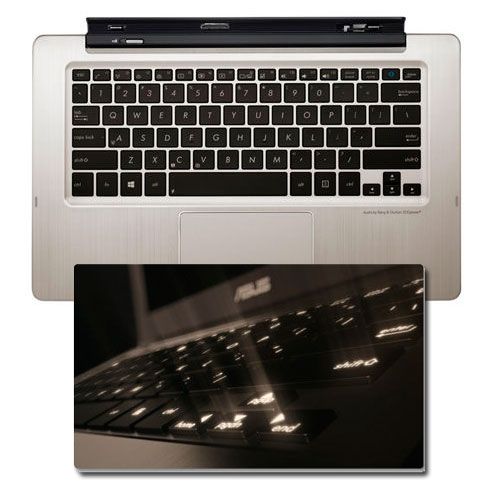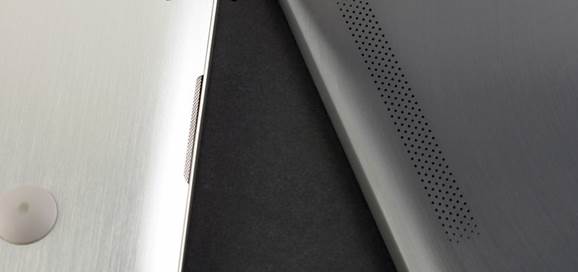Keyboard Dock and Trackpad
If you have owned or played with a Zenbook
Prime before, you would know what to expect with the Transformer Book: it has
basically the same backlit keys as ASUS' earlier offerings (everything after
the original UX31). For some time now, these keyboards have had plastic, not
metal, buttons, with a good deal more travel than they used to. In fact, the
company has slightly adjusted the key travel this time, making it the only
change compared to the previous model.

It
has basically the same backlit keys as ASUS' earlier offerings
Whether ASUS made the buttons deeper or
shallower is hard to tell: they feel about the same. All that we know is the
keyboard provides more tactile feedback than most ultraportables, and that the
buttons are bouncy and well-spaced enough that typos are unlikely (however,
we're sure you can find a way). When you think of the Asus' first Ultrabook,
where we had to mash the keys to make sure our presses registered, we're
reminded of how far the company has come, at least in terms of typing
experience. Currently, the Asus keyboard does not attract much attention. And
that's a good thing.
Talking about the key a little more, you
will find a few functions built into specific buttons. The space bar, for
instance, has a control on the left end that activates the Power4Gear Hybrid
application, where you can select different power management profiles. The
"C" key doubles as a shortcut for ASUS' Splendid Video Technology
dashboard, where you change the display setting to "Theater",
"Vivid" or any manual configuration. (We had it open in the default
mode for most of the time). The "A" key contains an on/off switch for
the ambient light sensor. Meanwhile, the "V" key is where you will
find one shortcut for the Asus' LifeFrame camera app, which has all the photo
filters, borders and emoticons you'd expect from a typical notebook webcam. Of
course, the Function keys house all your requisite volume and brightness controls.
In this case, you need to use the Fn key to activate them, which is either good
news or bad news depending on how much you rely on keyboard shortcuts.

Even
single-finger tracking is precise
ASUS has come a long way with its trackpads
too. The one here, which used the Asus drivers, is not bad. We enjoyed smooth,
controlled pinch-to-zooming in IE10, and didn't even have to apply much
pressure with our fingers. Two-finger scrolls are good too. Even single-finger
tracking is precise, which can be the first thing to complain when we checked
out laptop touchpads. If you have complained that the touch-sensitive buttons
is a bit hard, but it is easy to let slide when compared with some other issues
we're used to.
Display and Sound
Asus is one of the first companies to offer
1080p on an Ultrabook, and it is also one of the first to release a tablet with
a 1920x1200 screen. So it is not surprising that the company went all out on
its flagship Transformer Book. What we have here is the 13.3-inch IPS display
with 1920x1080 resolution, 72% color gamut and a brightness rating of 350 nits
- about as bright as laptops get. Compared with a touch screen device such as
Toshiba's new Kirabook, the bezels are fairly wide, although at least the glass
is nearly edge-to-edge. (All touchscreens have at least some sort of bumper
along the sides).

4
speakers: 2 on the tablet, 2 on the dock
In addition to the bezel, it's of typical
ASUS quality,which is to say the colors are vivid and the viewing angles are
wide, especially from the front with the lid is pushed forward. Although the
glossy finish usually reflects light, we were impressed how the colors remain
vivid even when we change positions to watch from off-kilter angles. Obviously,
all of that starts to fall apart as you move toward a 180-degree angle, but how
many of you really watch Netflix out of your peripheral vision anyway?
As it is doing with other Ultrabooks, Asus
has used Bang & Olufsen ICEpower audio setup, with 4 speakers and MaxxAudio
technology on the software side. Thus, the equation hasn't changed, and neither
has our opinion: the computer pulls off some surprisingly not-tinny
(relatively) sound but the volume is low, even for a small laptop. We love
hearing everything from The Clash to Ray Charles, but sometimes we kept hitting
the volume-up key only to be reminded that we were already maxed out. Obviously
that's not a big deal.